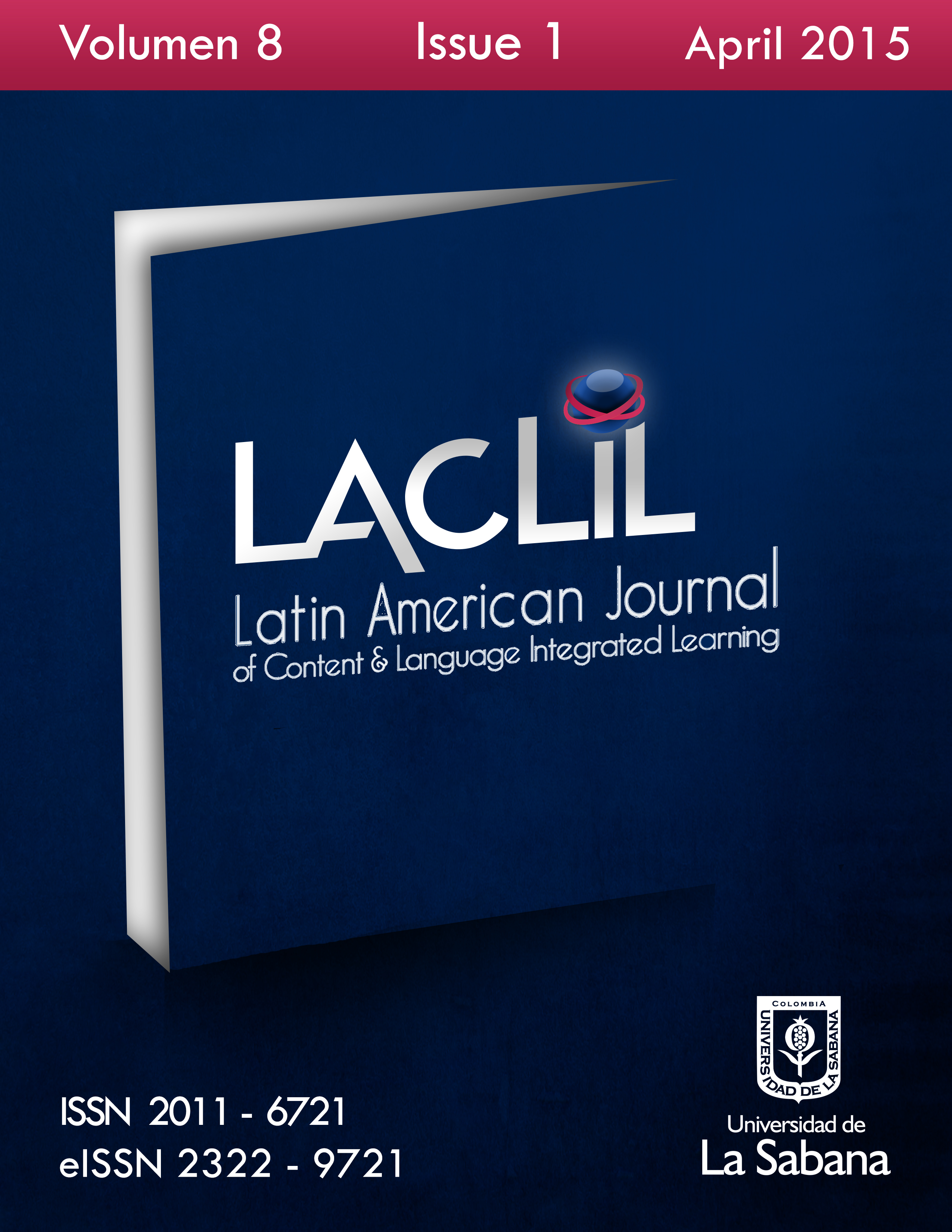Comparing the language policies and the students’ perceptions of CLIL in tertiary education in Spain and Japan
DOI:
https://doi.org/10.5294/5091Keywords:
AICLE, educación terciaria, bi-/multilingüismo, España, Japón, percepciones de estudiantes sobre el AICLE.Abstract
Content and language integrated learning (CLIL) was widely implemented in the education system in Europe in the mid-1990s based on their multilingual education policy. CLIL integrates acquisition of subject knowledge with language learning, either a second or foreign language, simultaneously. Recently, CLIL in English has been introduced in higher education in Japan although its implementation is still at an early stage. This article aims to provide a brief overview of CLIL in higher education in Spain, which advances CLIL research, and in Japan in relation to the social economic rationales, and to investigate students’ perceptions of CLIL implementation in the two countries through questionnaire surveys.
The results show differences in social economic rationales of CLIL implementation in both countries: CLIL in Spain, on the one hand, is ‘proactive’ (Coyle, Hood & Marsh 2010), adhering the bilingual and multilingual education policy in the European Union. In Japan, on the other hand, introduction of CLIL seems to be ‘reactive’ to provide human resources with English proficiency for its economic purposes. In terms of students’ perceptions, about a half of the respondents in both countries shows a positive view of CLIL at tertiary level.
Downloads
References
Bonnet, A., & Dalton-Puffer, C. (2013). Great Expectations?: Competence and Standard Related Questions Concerning CLIL Moving into the Mainstream. In S. Breidback & B. Viebrock (Eds.), Content and Language Integrated Learning (CLIL) in Europe: Research Perspectives on Policy and Practice (pp. 269-284). Frankfurt: Peter Lang GmbH.
Butler-Goto, Y., & Iino, M. (2005). Current Japanese reforms in English language education: the 2003 "Action Plan". Language Policy, 4(1), 25-45.
Commission of the European Communities. (2003). Promoting Language Learning and Linguistic Diversity: An Action Plan 2004-2006. Retrieved 16 Sep 2013, from http://ec.europa.eu/education/doc/official/keydoc/actlang/act_lang_en.pdf
Council of Europe. (1982). Recommendation No, R (82): 18. Retrieved 16Sep2013, from https://wcd.coe.int
Council of Europe. (2001). Common European Framework of Reference for Languages: Learning, Teaching, Assessment. Cambridge: Cambridge University Press.
Coyle, D., Hood, P., & Marsh, D. (2010). Content and Language Integrated Learning. Cambridge: Cambridge University Press.
Dobson, A., Murillo, M., Dolores, Perez, & Johnstone, R. (2010). Bilingual Education Project Spain Evaluation Report. Retrieved 24 Jul 2012, from http://www.mecd.gob.es
European Commission. (1995). Teaching and Learning: Towards the Learning Society: White Paper on Education and Training. Retrieved 16 Sep 2013, from http://ec.europa.eu
European Commission. (1999). The Bologna Declaration on the European Space for Higher Education. Retrieved 16Sep2013, from http://ec.europa.eu
European Commission. (2010). The Bologna Process- Towards the European Higher Education Area. Retrieved 16 Sep 2013, from http://ec.europa.eu/education/higher-education/bologna_en.htm
Fernandez-Santiago, M. (2011). Integration or immersion?: a comparative study at the tertiary level. Latin American Journal of Content & Language Integrated Learning, 4(1), 49-64.
Fortanet-Gomez, I. (2013). CLIL in Higher Education: Toward a
Multilingual Language Policy. Bristol: Multilingual Matters.
Garcia, A. M. R. (2013). Higher Education Bilingual Programmes in Spain. Porta Linguarum, 19, 101-111.
Ikeda, M., Pinner, R., Mehisto, P., & Marsh, D. (2013). Editorial. International CLIL Research Journal, 2(1).
Ikeda, M. (2013). Does CLIL work for Japanese secondary school students?: potential for the 'weak' version of CLIL. International CLIL Research Journal, 2(1), 31-43.
Izumi, S., Ikeda, M., & Watanabe, Y. (2012). CLIL (Content and Language Integrated Learning): New Challenges in Foreign Language Education at Sophia University. Volume 2: Practice and Applications (in Japanese). Tokyo: Sohia University Press.
Llinares, A., Morton, T., & Whittaker, R. (2012). The Role of Language in CLIL. Cambridge: Cambridge University Press.
Mehisto, P., Marsh, D., & Frigols, M-J. (2008). Uncovering CLIL: Content and Language Integrated Learning in Bilingual and Multilingual Education. Oxford: Macmillan Education.
METI (2010). Develop Global Human Resources through Industry-Academic-Government Collaboration. Tokyo: Ministry of Economy, Trade and Industry. Retrieved Retrieved 16 Sep 2013, from http://www.meti.go.jp
MEXT. (2002) Japanese Government Policies in Education, Culture, Sports, Science and Technology 2002. Ministry of Education, Culture, Sports, Science and Technology Japan.
MEXT. (2003). An Action Plan to Cultivate 'Japanese with English Abilities'. Ministry of Education, Culture, Sports, Science and Technology Japan.
MEXT. (2009). Global 30. Ministry of Education, Culture, Sports, Science and Technology Japan. Retrieved 17 May 2014, from http://www.uni.international.mext.go.jp/
MEXT (2011). Daigaku ni okeru kyoiku naiyou tou no kaikaku jokyo (Reform in Higher Education). Retrieved 17 May 2014, from http://www.mext.go.jp/a_menu/koutou/daigaku/04052801/1341433.htm
MEXT. (2012). Higher Education in Japan. Higher Education Bureau, Ministry of Education, Culture, Sports, Science and Technology Japan.
MEXT. (2013). English Education Reform Plan corresponding to Globalization. Ministry of Education, Culture, Sports, Science and Technology Retrieved 10 Feb 2015, from http://www.mext.go.jp/english/topics/1343591.htm
MEXT. (2014). Selection for the FY 2014 Top Global University Project. Ministry of Education, Culture, Sports, Science and Technology Japan.
Sasajima, S. (Ed.). (2011). CLIL: Content and Language Integrated Learning (in Japanese). Tokyo: Sanshusha.
Smit, U., & Dafouz, E. (2012). Integrating content and language in higher education: an introduction to English-medium policies, conceptual issues and research practices across Europe. AILA Review, 25, 1-12.
Spies, K. (2012). Intercultural studies within a CLIL approach. Latin American Journal of Content & Language Integrated Learning, 5(1), 33-45.
Tanabe, Y. (2004). What the 2003 MEXT Action Plan proposes to teachers of English. The Language Teacher, 28(3).
Tsuchiya, K. (2014). Learning intercultural communication in a CLIL classroom (in Japanese). The Report of Foreign Language Centre, Tokai University, 34, 61-70.
Downloads
Published
How to Cite
Issue
Section
License
This Journal and its articles are published under the Creative Commons CC BY 4.0 DEED Attribution 4.0 International license. You are free to: Share — copy and redistribute the material in any medium or format for any purpose, even commercially. Adapt — remix, transform, and build upon the material for any purpose, even commercially. The license cannot revoke these freedoms as long as you follow the terms of the license.








